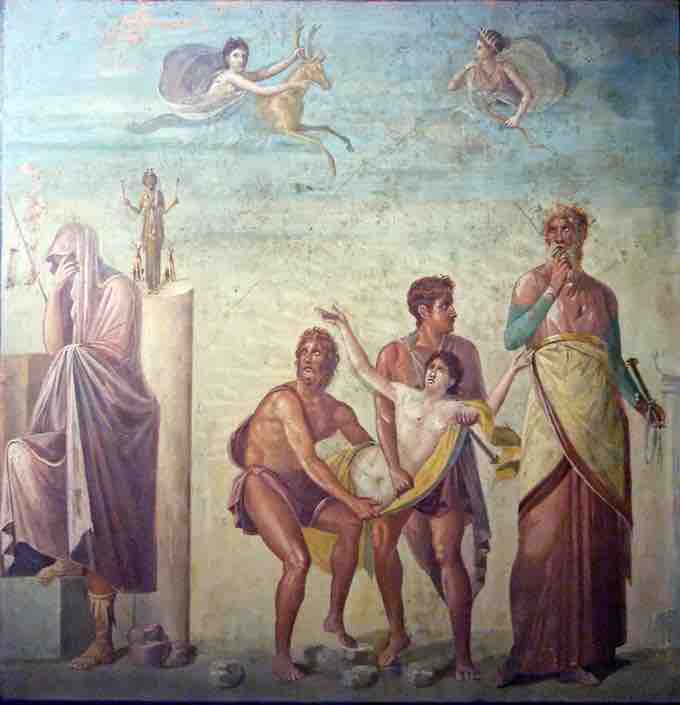As discussed previously, the fresco paintings discovered at Pompeii were studied and classified by the German art historian August Mau in the end of the 19th century. Mau classified Roman painting into four developmental styles using the surviving Pompeiian paintings. While it was due to Mau that Pompeiian art became the model used in classifying Roman painting styles, the uniqueness of several of the paintings and houses deserves a closer look.
Riot at the Amphitheatre
In 59 CE, a riot broke out between the citizens of Pompeii and the citizens of nearby Nuceria during a gladiatorial event. The brawl in the amphitheater resulted in serious injuries between both parties and the banning of all gladiatorial events for ten years. A fresco from Pompeii that depicts the event has also survived. The fresco depicts the Pompeiian amphitheatre, with its distinctive exterior staircase, as well as an awning, the velarium. It also depicts the riot occurring both inside the arena and on the grounds surrounding the amphitheatre.

Riot at the Pompeii Ampitheatre
Depiction of a riot at the amphitheatre at Pompeii. Pompeii, Italy. ca.60-79 CE.
Villa of the Mysteries
At the Villa of the Mysteries, just outside of Pompeii, a fantastic scene filled with life-size figures depicts a ritual element from a Dionysian mystery cult . In this Second Style example, architectural elements play a small role in creating the illusion of ritual space. The people and activity in the scene are the main focus. The architecture present is mainly piers or wall panels that divide the main scene into separate segments. The figures appear life-size, which brings them into the space of the room.

Villa of the Mysteries
One wall on the ritual scene depicted at the Villa of Mysteries. Pompeii, Italy. ca. 60-50 BCE.
The scene wraps around the room, depicting what may be a rite of marriage. A woman is seen preparing her hair. She is surrounded by other women and cherubs while a figure, identified as Dionysus, waits. The ritual may reenact the marriage between Dionysus and Ariadne, the daughter of King Minos. All the figures, except for Dionysus and one small boy, are female. The figures also appear to interact with one other from across the room. On the two walls in one corner, a woman reacts in terror to Dionysus and the mask over his head. On the opposite corner, a cherub appears to be whipping a woman on the adjoining wall. While the cult aspects of the ritual are unknown, the fresco demonstrates the ingenuity and inventiveness of Roman painters.
House of the Vettii
Many rooms in the House of the Vettii are lavishly painted. Each triclinium is themed and painted in the Fourth Style. Each panel in the room follows the room's theme, providing visual entertainment and a narrative during dining. The Ixion Room, for instance, is a model of Fourth Style wall painting. Within each red panel is a scene depicting myths where the main character commits a major slight. One panel is dedicated to Ixion, who refused to pay a dowry and murdered his father-in-law. He also lusted after Zeus's wife, betraying the relationship between guest and host. Another panel depicts Daedalus presenting a wooden cow to Pasiphaë, wife of King Minos, so she could relieve her lust for a white bull . From this union, Pasiphaë birthed the Minotaur, a half-man, half-bull monster. Another Fourth Style triclinium depicts scenes from the lives of Hercules and Theseus.

Daedalus and Pasiphae
Daedalus presents Pasiphae with a wooden heifer.
House of the Tragic Poet
The atrium of the House of the Tragic Poet includes a series of paintings depicting scenes from the Trojan War. The panels on the walls depict scenes that appear to be interrelated. Just like the mythological panels in the House of the Vettii are related to each other based on a common theme so, too, do many of these scenes. Scholars believe themes were carefully crafted not only to relate stories, but also to depict the virtues of the house's owner.
Two panels on the south wall relate the beginnings of the Trojan War. One panel is of Zeus and Hera on Mount Ida. Another, badly damaged, appears to be a scene of the Judgment of Paris. These panels relate the beginnings of the Trojan War while portraying womanly ideals. Two pairs of scenes, set across from each other, depict different, interrelated themes. The abduction of women is one theme visible in one image of Helen with Paris leaving for Troy. Another image portrays the abduction of Amphitrite by Poseidon. In both cases, a male abducts a woman. The other two scenes deal with the argument between Achilles and Agamemnon, which begins the story of the Illiad. Of these two scenes, one depicts Achilles with Agamemnon, while the other depicts Achilles returning Briseis, his lover and captive, to his commander, Agamemnon. A final image, found in the peristyle, depicts the Sacrifice of Iphigenia . All of these paintings are related to one another through themes such as marriage, womanly virtue, and the Trojan War.

Sacrifice of Iphigenia
Fresco scene of the Sacrifice of Iphigenia. House of the Tragic Poet, Pompeii, Italy. Ca. 60-65 CE.